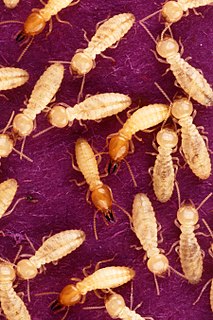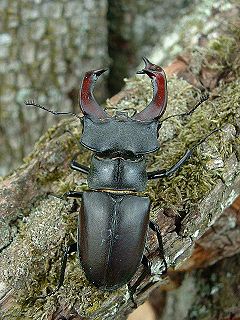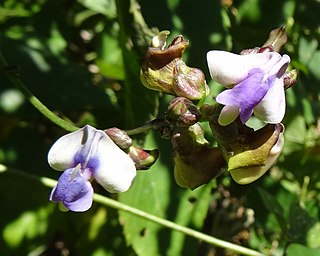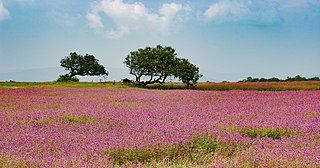
The Lamiaceae or Labiatae are a family of flowering plants commonly known as the mint or deadnettle or sage family. Many of the plants are aromatic in all parts and include widely used culinary herbs like basil, mentha, rosemary, sage, savory, marjoram, oregano, hyssop, thyme, lavender, and perilla, as well as other medicinal herbs such as catnip, salvia, bee balm, wild dagga, and oriental motherwort. Some species are shrubs, trees, or, rarely, vines. Many members of the family are widely cultivated, not only for their aromatic qualities, but also their ease of cultivation, since they are readily propagated by stem cuttings. Besides those grown for their edible leaves, some are grown for decorative foliage. Others are grown for seed, such as Salvia hispanica (chia), or for their edible tubers, such as Plectranthus edulis, Plectranthus esculentus, Plectranthus rotundifolius, and Stachys affinis. Many are also grown ornamentally, notably coleus, Plectranthus, and many Salvia species and hybrids.

Patchouli, from Tamil paccuḷi, is a species of plant from the family Lamiaceae, commonly called the "mint" or "deadnettle" family. The plant grows as a bushy perennial herb, with erect stems reaching around 75 centimetres (2.5 ft) in height and bearing small, pale pink-white flowers. It is native to tropical regions of Asia. It has many commercial uses and is now extensively cultivated in China, Indonesia, Japan, Cambodia, Myanmar, India, Maldives, Malaysia, Mauritius, Seychelles, Madagascar, Taiwan, Pakistan, the Philippines, Thailand, Vietnam, South America and the Caribbean.

Pogostemon is a large genus from the family Lamiaceae, first described as a genus in 1815. It is native to warmer parts of Asia, Africa, and Australia.

The Formosan termite is a species of termite that has been transported worldwide from its native range in southern China to Taiwan, Japan, South Africa, Sri Lanka, Hawaii, and the continental United States.

Anoectochilus, commonly known as marbled jewel orchids or filigree orchids, is a genus of about fifty species in the orchid family Orchidaceae. They are terrestrial herbs with a creeping rhizome, an upright flowering stem and dark coloured leaves with contrasting veins. The flowers are relatively large and have a large labellum, markedly different from the sepals and petals.

Pogostemon stellatus is an aquatic perennial herb from eastern and southeastern Asia, the Indian Subcontinent, New Guinea, and northern Australia. Because of its extensive geographic distribution, there are many different color and leaf forms of this plant in the wild. It is a highly prized and sought after aquatic plant in the aquarium trade.
Sinopanax formosanus is a species of flowering plant in the family Araliaceae and the only species in the genus Sinopanax. It is endemic to Taiwan. It is a small, evergreen tree, up to 12 metres (39 ft) in height, that grows in open areas in mountainous forests at altitudes between 2,300–2,600 metres (7,500–8,500 ft).

Lucanus is a genus of stag beetles (Lucanidae).

Hynobius formosanus, the Taiwan salamander, is a species of salamander in the family Hynobiidae, endemic to Taiwan, where it occurs in the high mountains at around 2,100 m (6,900 ft). Its natural habitats are from open alpine habitats to shaded moist evergreen forests. Adults have a total length of 58–98 mm (2.3–3.9 in).

Oncorhynchus masou formosanus, the Formosan landlocked salmon or Taiwanese salmon, is a freshwater salmonid fish endemic to Taiwan.
Lithocarpus formosanus is a species of tree in the family Fagaceae. L. formosanus is a medium-sized tree with crooked trunk and many branches. It is endemic to Taiwan as it only occurs in the Hengchun Peninsula in the extreme south of the country. It grows in mixed mesophytic forests at altitudes of 100–500 m (330–1,640 ft). Only single population of fewer than 50 individuals survives.

Rhinotermitidae is a family of termites (Isoptera). They feed on wood and can cause extensive damage to buildings or other wooden structures. About 345 species are recognized, among these are severe pests such as Coptotermes formosanus, Coptotermes gestroi, and Reticulitermes flavipes.

Dolichos is a genus of flowering plants in the legume family, Fabaceae, and the subfamily Faboideae. It is distributed in Africa and Asia.

The Kas Plateau Reserved Forest, also known as the Kaas Pathar, is a plateau situated 25 kilometres west from Satara city in Maharashtra, India. It falls under the Sahyadri Sub Cluster of the Western Ghats, and it became a part of a UNESCO World Natural Heritage Site in 2012.
Liobagrus formosanus is a species of catfish in the family Amblycipitidae. It is endemic to Taiwan. This species reaches a maximum length of 8.6 centimetres (3.4 in) standard length.

Achalinus formosanus, common name Formosan odd-scaled snake or Taiwan burrowing snake, is a non-venomous snake in family Xenodermidae that is found in Taiwan and in the southern Ryukyu Islands (Japan).

Pogostemon purpurascens is a small herbaceous, flowering plant found in the Western Ghats in South India. It is in the mint family, Lamiaceae.

Odontotermes, commonly known as the fungus-growing termites, is a termite genus belonging to family Termitidae, which is native to the Old World. They are most destructive in wooden homes, and are agricultural pests in the tropics and subtropics of Africa and Asia.

Lamioideae is a subfamily of plants in the family Lamiaceae.














